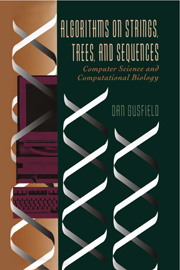Book contents
- Frontmatter
- Contents
- Preface
- I Exact String Matching: The Fundamental String Problem
- II Suffix Trees and Their Uses
- III Inexact Matching, Sequence Alignment, Dynamic Programming
- IV Currents, Cousins, and Cameos
- 16 Maps, Mapping, Sequencing, and Superstrings
- 17 Strings and Evolutionary Trees
- 18 Three Short Topics
- 19 Models of Genome-Level Mutations
- Epilogue – where next?
- Bibliography
- Glossary
- Index
17 - Strings and Evolutionary Trees
from IV - Currents, Cousins, and Cameos
Published online by Cambridge University Press: 23 June 2010
- Frontmatter
- Contents
- Preface
- I Exact String Matching: The Fundamental String Problem
- II Suffix Trees and Their Uses
- III Inexact Matching, Sequence Alignment, Dynamic Programming
- IV Currents, Cousins, and Cameos
- 16 Maps, Mapping, Sequencing, and Superstrings
- 17 Strings and Evolutionary Trees
- 18 Three Short Topics
- 19 Models of Genome-Level Mutations
- Epilogue – where next?
- Bibliography
- Glossary
- Index
Summary
The dominant view of the evolution of life is that all existing organisms are derived from some common ancestor and that a new species arises by a splitting of one population into two (or more) populations that do not cross-breed, rather than by a mixing of two populations into one. Therefore, the high level history of life is ideally organized and displayed as a rooted, directed tree. The extant species (and some of the extinct species) are represented at the leaves of the tree, each internal node represents a point when the history of two sets of species diverged (or represents a common ancestor of those species), the length and direction of each edge represents the passage of time or the evolutionary events that occur in that time, and so the path from the root of the tree to each leaf represents the evolutionary history of the organisms represented there. To quote Darwin
… the great Tree of Life fills with its dead and broken branches the crust of the earth, and covers the surface with its ever-branching and beautiful ramifications.
[119]This view of the history of life as a tree must frequently be modified when considering the evolution of viruses, or even bacteria or individual genes, but remains the dominant way that high-level evolution is viewed in current biology. Hundreds (may be thousands) of papers are published yearly that depict deduced evolutionary trees.
- Type
- Chapter
- Information
- Algorithms on Strings, Trees and SequencesComputer Science and Computational Biology, pp. 447 - 479Publisher: Cambridge University PressPrint publication year: 1997



